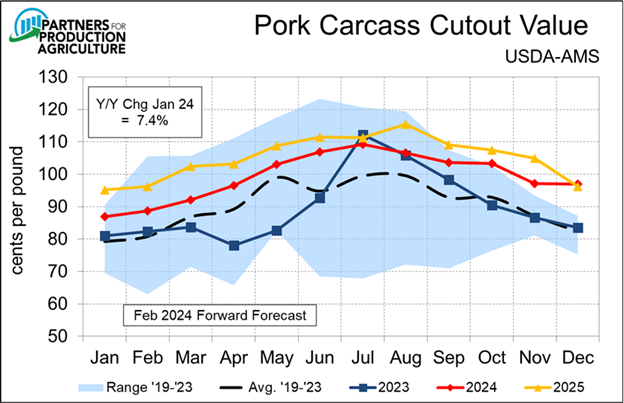Porkflation and the observations of HogBoiii
Whether or not we hold onto our fortunes may be impacted by the upcoming March 28 Hogs and Pigs report.
March 18, 2024

Perhaps not quite yet in the lexicon that passes through your email spellcheck, the appreciation of pork values in the face of increased runs may warrant a new term. The infamous HogBoiii of Twitter calls it “porkflation.” (Author’s Note: Bidenomics does not make it through spell check either.)
After a dismal showing in 2023, the start of the new year is in sharp contrast – thankfully – to our previous experience in spite of weekly slaughter levels that show no signs of a deficit of live animals available to the packer. How do we explain this? Dr. Meyer has recently cited an increase in calculated Demand (intentionally with a capital “D”, demand is disappearance at a price) as a primary factor to our fortunes.
The attached chart depicts our wholesale relationship that is migrating back toward the 2021-2022 experience – this is good news. This shift is a combination of both domestic offtake as well as excellent export numbers. So far in 2024, our exports are up 6% and trading at a value that is 6% higher. Normally, you would have to “buy” the added volume via a discounted price if all else was static. That is clearly not the case and the movement of additional pounds at a higher price is a depiction of a shift in the demand curve in our favor. Thank you, Mexico, for driving this growth.

Whether or not we hold onto our fortunes may be impacted by the upcoming March 28 Hogs and Pigs report. Reported disease pressure in given geographies is contrasted with productivity increases in many systems. It is this productivity increase that seems to be coming to bear with current runs of animals that would imply more output than the December report indicated.
Taking a peek at what the balance of this year and forward view of what next year may hold is depicted in the chart below. Hint: it is pretty good. The revenue component of our business is the most important driver of profits and the current set up is quite favorable. This does not suggest a market signal for expansion given the constraint in packing capacity that was recently tightened by the announced closing of the Tyson facility in Perry, Iowa. We may weave a little-margin-for-error labyrinth in the fourth quarter given the absence of this plant.

So, what is a pork producer to do? Given the shuttering of the Perry facility and the fact that we have only closed October hogs over $90 four times in the history of the contract, we may want to consider some type of coverage as we approach this number. There are excellent opportunities in the options and insurance markets to facilitate protection while leaving the top side open. We would be happy to discuss with you what works for your operation.
Comments in this article are market commentary and are not to be construed as market advice. Trading is risky and not suitable for all individuals. Contact Kerns at [email protected].
About the Author(s)
You May Also Like





